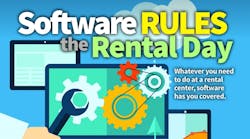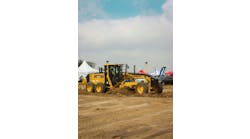In this month’s cover story we tried to give you a feel for how rental industry software is covering virtually every aspect of a rental operation. Software makes the yard staff more efficient, as well as the service technicians, the sales staff, accounting and other office support, truck drivers, and the counter personnel. It can help management slice and dice numbers in every possible way to help a company analyze its performance.
From what software companies tell me and from what I hear from rental company management, all of this information is tremendously useful. But there is one area I would like to see it applied more universally and vigorously and that is the analysis of rental rates. Matt Hopp of InTempo talks about it: If a customer wants to rent a particular piece of equipment and you know that it’s currently a high demand item and you’ve only got one or two on the lot, why in the world are you letting it go at a discounted rate? Save the discounts for when you’ve got a yard full of a particular item and limited demand.
Certainly many rental operators understand this attitude towards pricing, but not all. It would be helpful if you can program your software to be smart when it comes to rental rates. Maybe that will be the next frontier when it comes to rental software.
@ @ @ @
Earlier this year business was starting out strong and optimism was high in the rental industry. I was particularly impressed as I interviewed many of the executives of the RER 100 that demand was solid and they had high expectations for this year and next.
I’ve heard nothing from those leaders to suggest that it was going to slow down any time soon. I write this shortly before some of the public companies will be announcing how they did in the third quarter, and by the time you receive this magazine in the mail, some of you will have read their results and comments.
The latter part of 2016 was paced by strong nonresidential and commercial spending, which of course drives the rental industry more than any other sector. Many in the rental industry were hoping for tax reform and financial de-regulation, which would lead to greater capital investment, and we’ve seen some capital investment in this industry and more consolidation.
However, the United States economy, while certainly not doing poorly, is not growing with the exuberance some were hoping for. The current political environment is not likely, in the near future, to inspire brilliant legislative achievements, whether it be in terms of significant infrastructure spending, health care or tax reform, agreements on immigration or much of anything else. Optimism is not at its height right now. That said, being prepared for the unexpected is always a good plan.
The American Institute of Architects is predicting a construction slowdown over the latter part of 2017 and into 2018. It is projecting overall spending for nonresidential buildings at a bit less than 4 percent compared to a 5.6-percent forecast at the end of 2016. It is projecting industrial construction to decline almost 7 percent, compared to six months ago when it predicted an increase, and its expectation for institutional construction is now a 3.5-percent increase compared to the 5.7-percent jump it predicted entering 2017.
Another problem affecting the construction industry is lack of labor. Numerous organizations have mentioned it, especially the Association of General Contractors. Immigrant labor accounts for close to 30 percent of the construction labor force, and by far the majority of these are Latin American, especially Mexican. With current immigration policies strongly suppressing immigration from Latin America, the labor force, both highly skilled and minimally skilled is taking a major hit. Unemployment is low in the economy overall and the construction industry is no exception.
Still overall, AIA’s Consensus Construction Forecast is expecting a 3.5- to 4 percent construction growth for the remainder of 2017 and 2018 and that’s not bad at all. The AIA analysts don’t see much risk of a recession in the overall economy, but expect the economy to grow at a 2 percent to 2.5 percent range through the end of 2018.
Rental companies are, for the most part, reporting steady demand in most areas of the country. I expect a continued aggressive stance from most rental companies with relative caution when it comes to dramatic expansion.







